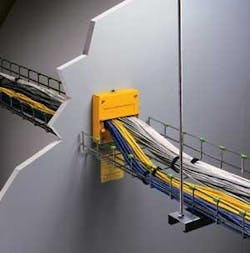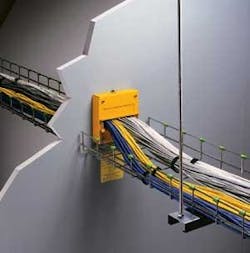New product sets solve problems, while widespread industry awareness remains a critical objective.
In the realm of firestopping, each year sees the introduction of new products and systems to the marketplace, designed to provide solutions to challenging firestop problems. Each year also, hopefully, marks progress in the overall industry's effort to promote education far and wide across the country—among firestopping contractors, building inspectors, and code makers.
In late August and early September at the BICSI Fall Conference and Exhibition in Seattle, that trend of emerging technologies and educational progress was evident from several angles.
A trade group called the International Firestop Council (IFC—www.ifc.org), made up of firestopping manufacturers, contractors, and members of code-making bodies, has made education its charter and was represented at the BICSI Conference. The organization is spending much of its efforts and resources on education, its vice president Jim Park says. Park is a national sales manager, focusing on the construction market, for firestopping-system manufacturer Rectorseal.
Enforcement issues
"We are set up to educate building-code officials and contractors," Park says. There's a consensus among many in the industry that educational efforts are worthwhile, certainly necessary, and should continue.
"Enforcement of firestopping requirements varies greatly from municipality to municipality," says Jason Hood, national sales manager with Roxtec. "AHJs [authorities having jurisdiction] can definitely provide resistance against using certain products if they are not familiar with them; however, if you have UL-1479 approval and the customer wants to use the product, there usually is very little resistance." Hood adds that some major metropolitan areas require separate registration and approval for firestopping products.
As part of its educational efforts, the IFC has created the Firestopping Inspection Manual specifically for inspectors, now in its second edition. The IFC also has compiled Inspection Guidelines for Penetration Firestop Systems and Fire-Resistive Joint Systems in Fire-Resistance Rated Construction, which is in its third edition.
Active and passive prevention
Park explains the relationship that binds building codes, firestopping systems, and the contractors who install those systems: "Codes are concerned with life-safety, not saving property." The three means of property protection from fire are:
- Detection, which is achieved through alarms;
- Suppression, accomplished by sprinkler systems, Halon, fire extinguishers, and the like;
- Compartmentation.
Fire suppression amounts to active fire protection, while compartmentation is passive fire protection. So what, exactly, is compartmentation? A fact sheet produced by the IFC states: "Passive fire protection systems aid in the containment of fires within the areas in which they start, preventing smoke, hot gases, and flames from spreading throughout a building."
Park emphasizes that all three fire-protection means are necessary for protection of a building and its occupants.
Jim Stahl, Jr., director of technical services with Specified Technologies Inc., also explained the concept of compartmentation during the opening of a presentation he made at the recent BICSI Conference. Most of his presentation focused on myths versus facts with regard to firestopping systems and techniques. Stahl says the presentation's content was a natural product of his experience with firestopping technical service.
"Being involved in the industry for a lot of years, and working in technical services for a long time, I have heard some of the same questions repeated many times from different contractors," Stahl explains. "In many cases, the contractor's question starts with, 'I heard this…' or 'Can you confirm for me that…'."
Among the myths that Stahl dispelled in his presentation is the belief that cable trays may not run through fire-rated floors or walls. (See sidebar, below, for his complete lineup of myths vs. facts.) In fact, there are no restrictions on running cable trays through such barriers.
"There are many acceptable methods for running cables through fire-resistance rated barriers; it is up to designers and installers to determine which method best suits their site-specific condition," Stahl says, neither advocating nor denouncing the practice of running cable through fire-rated walls.
The trouble with trays
That lack of a restriction, however, does not solve all issues surrounding cable-tray penetration through fire-rated walls. Mike Tobias, president of Unique Fire Stop Products, has lectured on the topic for a couple years. Tobias recommends stopping the cable tray's path a few feet short of the fire barrier, using a sleeve system through the fire-rated wall, then running the cable tray again on the other side of the wall.
Wording in the 4th edition of BICSI's ITS Installation Manual appears to echo Tobias' stance. A full chapter of the manual—40 pages total—is devoted to firestopping. The section on cable tray reads, in part: "Trays can be difficult to properly fire seal during the initial installation, and firestop materials may not be properly replaced if untrained staff undertakes future installation work. Designers often specify the use of sleeves to penetrate a rated barrier between two sections of cable tray. This allows the cabling installer to use common materials to seal the cables within a sleeve… If it becomes necessary to utilize a tray through a barrier, the cabling installer must obtain a specific firestop product design and approval for its use from the local fire inspection authority."
At the BICSI Conference in Seattle, The Wiremold Company introduced a set of through-wall fittings that aims to serve the cable-tray-through-firewall scenario. Called FlameStopper (see photo, pg. 42), the product set combines built-in intumescent firestopping material with an enclosed wall penetration.
Click here to download a .pdf of the Product Update Table.
Assessing the systems
The wheels continue to turn for firestopping, and by all accounts that is a good thing. Users can assess systems based on several criteria, including:
- F ratings for direct-flame tolerance;
- T ratings for temperature-rise suppression;
- L ratings for air/smoke leakage prevention;
- W for the restriction of water flow through penetrations in ceilings, floors, and walls—the newest rating developed by Underwriters Laboratories.
- Class 1-rated system, which will resist up to three feet of water pressure;
- Class 2-rated system, which will resist up to 20 feet of pressure;
- Class 3 system, which resists up to 50 feet of water pressure.
UL's F and T ratings are mandatory for firestopping systems, and its L and W ratings are optional.
While this evolution takes place, the industry is moving forward with educational initiatives to help ensure sound installation practices and inspection methods are employed.
PATRICK McLAUGHLIN is chief editor of Cabling Installation & Maintenance.
Firestopping: Myth vs. Fact
The following information is taken from the presentation Firestopping: Myths vs. Facts, Dispelling Myths Regarding Proper Firestopping, presented by Jim Stahl, Jr., director of technical services with Specified Technologies Inc. (www.stifirestop.com).
Myth: Firestop caulk must be red.
Fact:There is no model building code requirement anywhere that mandates proper color; however, most manufacturers deliberately use colors that stand out to facilitate inspection, and different colors to distinguish between products.
Myth: Polyurethane foam is a firestop.
Fact:Frequently used as draft stops, polyurethane foams burn vigorously and are not acceptable firestopping materials. Some are UL-classified for surface flammability only, but not fire resistance.
Myth: Firetape and drywall "mud" make a firestop.
Fact:It is not, for a number of reasons. It is not in the UL Fire Resistance Directory; it is only an acceptable element in rated construction when used to seal joints in boards; and it does not meet the test criteria created by the National Fire Protection Association or any model building code required for firestopping.
Myth: Concrete, mortar, and grout are firestops.
Fact:While all perfectly good for their intended purposes, they are untested and never should be used for firestopping. Concrete may spall during a fire; mortar may spall or shrink at temperatures that could reach 2000°. Fahrenheit; and grout materials may burn out or shrink during a fire.
Myth: Fire safing is an adequate firestop.
Fact:Fire safing, or packing an opening with mineral wool, certainly is better than doing nothing. But it is not a firestop. Using mineral wool alone does not provide a smoke seal, does not address combustible penetrants, and cannot withstand the shock of a hose test.
Myth: Firestop and smoke seals must be airtight.
Fact:The codes recognize that this is impractical. Model codes do not clearly specify acceptable amounts of air leakage, and do not specify a method of quantifying leakage.
Myth: Cable trays may not be run through fire-rated floors or walls.
Fact:There are no restrictions against running cable trays through fire-rated barriers. NEC 392.6 (G) states, "cable trays are permitted to extend through partitions and walls or vertically through platforms and floors in wet or dry locations where the installations, complete with installed cables, are made in accordance with the requirements of 300.21." (300.21 requires these openings to be firestopped using approved methods.)
Myth: Sleeves are not required to be attached to the wall or floor. Only the inside of the sleeve must be sealed.
Fact:Sleeves are required to be firmly attached to the wall or floor and must be firestopped inside and out, per NEC 711.2.

